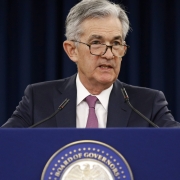Neither The Left Nor The Right Understand What Stimulates Economic Growth. Hint: It’s Not The Fed.
When the 21st century began, “internet cafes” were a thing. Hard as it may be for some to imagine now, bricks and mortar businesses existed into which individuals would enter with an eye on renting both a laptop and internet time.
The subsequent explosion of Wi-Fi and smartphone usage quickly rendered the internet café of the early 2000s unnecessary in short order. What was once a growing sector of the U.S. economy quickly fell into a major recession, only to disappear altogether.
This small piece of business history rates mention in consideration of the bipartisan belief that the Federal Reserve must act fast to allegedly stave off recession. As a New York Times editorial put it last week, “the argument for a rate cut is that the Fed should try to extend this economic expansion, which is now the longest period of uninterrupted growth in American history.” On the right, myriad arguments have been made (including by President Trump himself) that the Fed’s supposed “tight” monetary policy is the source of slower growth, and that rate cuts are necessary to extend the boom.
Translated to readers, left and right are both saying “you didn’t build that,” that the economy is reliant on the Fed’s ongoing fine-tuning via rate machinations. It’s easy to see why the left would take potshots at the most dynamic economy in the world, but it’s more than odd to see Trump and so many Trump partisans make such a weird case.
But first, it’s useful to backtrack. Recessions are painful, which is a statement of the obvious. At the same time, economies aren’t some blob that can be massaged. Economies are just people. During recessionary periods many people realize errors; hiring mistakes, bad habits developed, lousy investments – the list is long.
Somewhere around 2005 investors started to realize that their investments in internet cafes were set to be exposed as foolhardy by market forces. No doubt recognition of the errors was painful, but it also drove progress.
Which raises questions about fighting recessions? Have left and right lost their collective mind? If we ignore that there’s nothing about “growth” in the Constitution, and if we ignore just how overstated is the Fed’s ability to influence the economy as is (more on that in a bit), why on earth would both sides cheer on the fighting of recession or slower growth? Implicit in their extraordinary emotion is that the Federal Reserve should use its powers to help individuals, businesses and investors to delay correction of what’s not working. Translated, left and right are clamoring for stagnation.
After that, can we at least try to be serious about the Fed as “recession fighter”? It’s repeated regularly in this column that the Fed channels its way overstated influence through a U.S. banking system that is increasingly small as a percentage of total credit. To believe that the Fed and the banks it supposedly liquefies can boost overall economic growth is the equivalent of the federal government offering up a big loan to ABC, CBS and NBC in order to boost the television economy. Ok, but so much of the television we watch nowadays has little to do with the Big Three. The Fed is influencing what is small, and shrinking.
Taking this further, banks nowadays pay how much for deposits? At this point readers might check to see what they’re earning on their money market and savings accounts parked at banks. 2 or 2 ½%? Whatever the number, it is low. What that should tell anyone with a pulse is that the banks the Fed projects its influence through are being more than conservative at the moment with money in their control. If not, as in if they were taking big risks, they would be paying much more in pursuit of savers. That’s all well and good that banks are being careful, they must be conservative with monies in their care since they’re lending in order to earn income streams on loans made prudently, but it’s a reminder that banks have little to do with the growth of the most dynamic economy on earth.
In short, even if the Fed could or can liquefy banks, the act of doing so is superfluous. More specifically, there are already big pools of money out there eager to be directed toward the kind of lending done by banks. Assuming the Fed weren’t eager to liquefy them via lower rates, it’s no reach to say that well-run banks with good lending prospects toward the bluest of blue chip borrowers could easily expand their lending capacity in the markets themselves. Basically banks don’t need the Fed to enable the conservative allocation of money exchangeable for resources. Stating what should be obvious, if the economy is weak then conservative banks won’t revive it.
More on resources, it’s shooting fish in a crowded barrel to say that the Fed cannot create the resources that people and businesses borrow money to attain. This is worth repeating again and again amid all the hysteria about the Fed pursuing “monetary ease” to allegedly stimulate the economy. The Fed can do no such thing. We borrow money for what it can be exchanged for. Money itself is a non sequitur of the highest order absent goods to exchange it for. It’s just a reminder that borrowing can’t be stimulated by the Fed. Production is what always and everywhere precedes borrowing. That’s why it’s so disturbing to see so many supply-siders cheer on so-called Fed ease. Such cheerleading refutes Say’s Law. Production first, then consumption. Just the same, production first, then borrowing. Production is what enables borrowing, not price controls that supply siders have historically rejected.
Oh well, the Fed can’t alter reality. It can’t simply because just as investment powers economic growth, so does realization of error on the part of investors render credit tighter. Painful as the latter is, it’s necessary. Think internet cafes. Alleged Fed “ease” thankfully won’t perpetuate today’s equivalent of the internet café, or anything else presently being rejected in the marketplace. Thank goodness.
The main thing is that what stimulates economic growth isn’t central bankers, but instead great ideas brought to the market by great people, only for what’s great to be matched with intrepid capital. It’s a beautiful thing, but decidedly something that cannot be centrally planned, or made to happen cheaply through rate machinations by central banks. The left perhaps have never understood this (see their worship of government planning of economic outcomes), the right used to understand it, but now doesn’t. Next up surely has to be Trump channeling Richard Nixon with “We’re all central planners now!” That’s too bad.
John Tamny is editor of RealClearMarkets, and Director of the Center for Economic Freedom at FreedomWorks.





